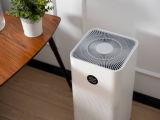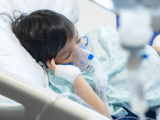Feb 20, 2013 (CIDRAP News) – In a new study, Chinese hospital staffers who wore N95 respirators all the time enjoyed significantly lower rates of clinical respiratory illnesses (CRIs) than workers who wore surgical masks or used N95s only for high-risk procedures.
The researchers also found that workers who continuously wore the respirators had lower rates of bacterial colonization when they had respiratory symptoms, according to their report in the American Journal of Respiratory and Critical Care Medicine.
The study, led by Australian researcher Raina MacIntyre, MB BS, PhD, may renew a long-running debate on respiratory protection for health workers. N95 respirators are designed to block at least 95% of airborne particles, but many healthcare workers (HCWs) find the close-fitting devices uncomfortable. Surgical masks are less uncomfortable, but air can easily leak around them.
Most countries have policies that recommend the use of surgical masks only or call for using N95s only for high-risk circumstances, such as aerosol-generating procedures. For example, the US Centers for Disease Control and Prevention recommends that HCWs wear a surgical mask when within 3 feet of a person who has symptoms of a respiratory infection.
MacIntyre and colleagues conducted their study in China because HCWs there are more used to wearing masks and respirators than their counterparts in Western countries. The investigation follows up on the team's similar study published in 2011, in which CRI rates were significantly lower in N95 wearers than in surgical mask wearers. But the researchers concluded that the study might have been too small to show a real advantage for N95s and that larger trials were needed.
The new study was a cluster randomized trial conducted in 68 emergency departments and respiratory wards of 19 Beijing hospitals. Random assignments to the three different arms of the trial were done by wards rather than individually, mainly because HCWs were more willing to participate if all their colleagues were offered the same interventions.
Participants were assigned to wear either a surgical mask at all times while on duty, an N95 respirator at all times, or an N95 only while involved in high-risk procedures. Those who wore the respirators underwent fit testing. The participants wore the masks for 4 weeks and were followed for 1 more week to cover the incubation of any pathogen picked up in week 4; the trial period was Dec 28, 2009, to Feb 7, 2010. They were asked to track their own compliance using a pocket-sized diary card.
The researchers used a number of end points, including a CRI, influenza-like illness (ILI), lab-confirmed viral respiratory infection, lab-confirmed influenza with symptoms, and lab-confirmed bacterial colonization in symptomatic participants.
A total of 1,669 nurses and doctors from the 68 wards were recruited, and all of them participated, the report says. The number of participants averaged 24.5 per ward. The clusters were much the same in demographic characteristics, but they differed by age, flu vaccination status, self-reported hand washing, and numbers of doctors and nurses.
Those in the targeted N95 group achieved the highest rate of self-reported compliance with the intervention: 82%. The continuous N95 wearers had the lowest compliance, 57%, while the mask wearers were in the middle at 66%.
The surgical mask arm had the highest rate of CRI at 17% (98 of 572), followed by the targeted N95 arm at 11.8% (61 of 516), and the continuous N95 arm, at 7.2% (42 of 581), with all the differences significant. The rates of confirmed viral infections were all below 4% and didn't differ significantly between study arms.
As with the CRI rates, rates of bacterial colonization in participants with CRIs differed significantly. They were highest in the mask wearers at 14.7% (84 of 572), followed by the targeted N95 group, with 10.1% (52 of 516), and the continuous N95 arm, 6.2% (36 of 581). The most common bacterial species found was Streptococcus pneumoniae.
In their statistical analysis, the authors compared both of the N95 groups with the surgical mask group, after adjusting for potential confounders. They calculated that the continuous N95 group had a 61% lower risk of CRI (hazard ratio [HR], 0.39; 95% confidence interval [CI], 0.21-0.71) and a 60% lower risk of bacterial colonization (HR, 0.40; 95% CI, 0.21-0.73). The targeted N95 arm also had a lower risk for CRI and bacterial colonization compared with the surgical mask group, but the differences weren't significant.
Using the same type of analysis, the researchers also found that, compared with the targeted N95 use, continuous N95 use offered significant protection against CRI (HR, 0.56; 95% CI, 0.32-0.98), but not against bacterial colonization.
The authors say their key finding is that continuous N95 use offers "significant protective efficacy against clinical infection . . . compared with targeted use and surgical masks, despite significantly poorer adherence" to the practice. "These results add weight to the findings of our previous study," they add.
They write that the failure to find a difference between the targeted N95 arm and the surgical mask group in their hazard-ratio analysis "could indicate equal inefficacy or equal efficacy of a magnitude too small to detect in this trial. Without a control arm (ie, no masks), which is ethically difficult to under take in hospital HCWs in China, this question cannot be resolved, but our previous trial showed no superiority of masks against controls."
In other comments, the researchers said the high frequency of bacterial colonization in symptomatic HCWs was a surprising finding. They commented that it may represent colonization without infection, but that "bacterial carriage density may be a predictor of invasive disease and of viral-bacterial co-infection."
They add, "Bacterial pathogens certainly cause occupational infection in HCWs, and whatever the clinical significance, our research shows that N95 respirators protect HCWs from bacterial carriage."
Although the study suggests that intermittent use of N95s may be little better than wearing a surgical mask, MacIntyre told CIDRAP News that she is not concerned that her findings might discourage the use of N95s.
"The science should be independent of politics and cultural norms," she commented by e-mail. "Our study addresses a proof of principle question about clinical efficacy. How it informs policy and changes culture and practice is the next step, and this may be a longer process, and needs to be informed by accumulation of evidence over time.
"There was a time that no-one wore a seatbelt while driving, and this has changed dramatically over the last half century. The findings of the study are clear, and if I were a health worker in an emergency department during a pandemic, I would certainly wear a respirator continuously."
MacIntyre CR, Wang Q, Seale H, et al. A randomized clinical trial of three options for N95 respirators and medical masks in health workers. Am J Resp Crit Care Med 2013 Feb 14 (Early online publication) [Abstract]
See also:
Related 2011 study by MacIntyre and colleagues in Influenza and Other Respiratory Viruses
Nov 5, 2009, CIDRAP News story on reanalysis of early version of 2011 study above
CDC guidance on use of masks to control flu transmission


















